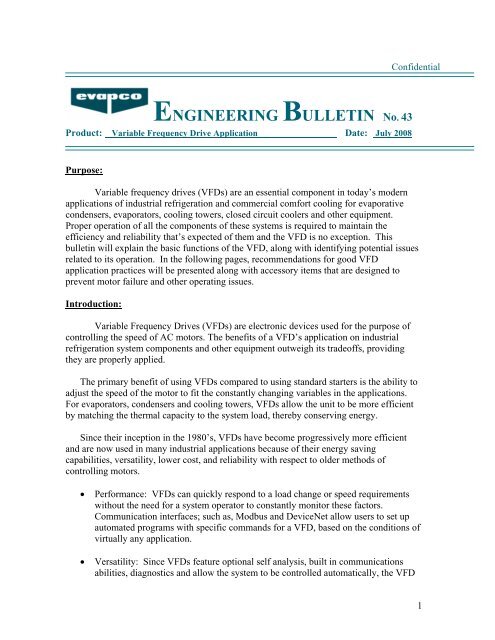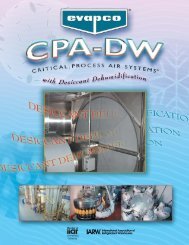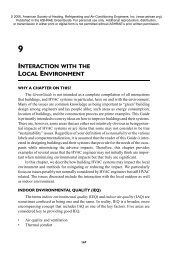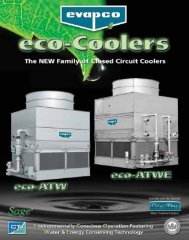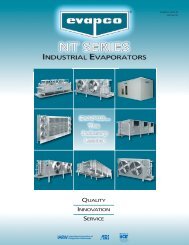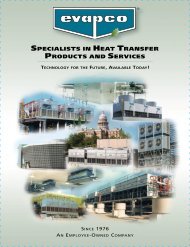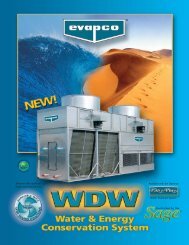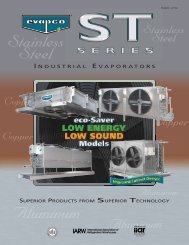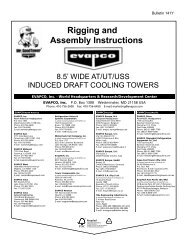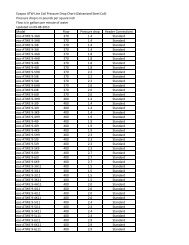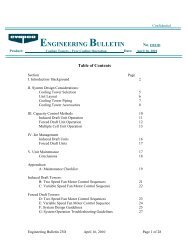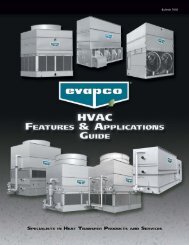Engineering Bulletin #43 VFD Application - Evapco
Engineering Bulletin #43 VFD Application - Evapco
Engineering Bulletin #43 VFD Application - Evapco
You also want an ePaper? Increase the reach of your titles
YUMPU automatically turns print PDFs into web optimized ePapers that Google loves.
Confidential<br />
ENGINEERING BULLETIN No. 43<br />
Product: Variable Frequency Drive <strong>Application</strong> Date: July 2008<br />
Purpose:<br />
Variable frequency drives (<strong>VFD</strong>s) are an essential component in today’s modern<br />
applications of industrial refrigeration and commercial comfort cooling for evaporative<br />
condensers, evaporators, cooling towers, closed circuit coolers and other equipment.<br />
Proper operation of all the components of these systems is required to maintain the<br />
efficiency and reliability that’s expected of them and the <strong>VFD</strong> is no exception. This<br />
bulletin will explain the basic functions of the <strong>VFD</strong>, along with identifying potential issues<br />
related to its operation. In the following pages, recommendations for good <strong>VFD</strong><br />
application practices will be presented along with accessory items that are designed to<br />
prevent motor failure and other operating issues.<br />
Introduction:<br />
Variable Frequency Drives (<strong>VFD</strong>s) are electronic devices used for the purpose of<br />
controlling the speed of AC motors. The benefits of a <strong>VFD</strong>’s application on industrial<br />
refrigeration system components and other equipment outweigh its tradeoffs, providing<br />
they are properly applied.<br />
The primary benefit of using <strong>VFD</strong>s compared to using standard starters is the ability to<br />
adjust the speed of the motor to fit the constantly changing variables in the applications.<br />
For evaporators, condensers and cooling towers, <strong>VFD</strong>s allow the unit to be more efficient<br />
by matching the thermal capacity to the system load, thereby conserving energy.<br />
Since their inception in the 1980’s, <strong>VFD</strong>s have become progressively more efficient<br />
and are now used in many industrial applications because of their energy saving<br />
capabilities, versatility, lower cost, and reliability with respect to older methods of<br />
controlling motors.<br />
• Performance: <strong>VFD</strong>s can quickly respond to a load change or speed requirements<br />
without the need for a system operator to constantly monitor these factors.<br />
Communication interfaces; such as, Modbus and DeviceNet allow users to set up<br />
automated programs with specific commands for a <strong>VFD</strong>, based on the conditions of<br />
virtually any application.<br />
• Versatility: Since <strong>VFD</strong>s feature optional self analysis, built in communications<br />
abilities, diagnostics and allow the system to be controlled automatically, the <strong>VFD</strong><br />
1
is a useful tool in a variety of cases. As mentioned the element of control allows for<br />
easy adjustment to different conditions and conserves energy by improving<br />
efficiency.<br />
• Cost: <strong>VFD</strong>s have no moving parts to maintain, no need for external controls and<br />
due to their increasing popularity they have become relatively inexpensive.<br />
• Reliability: Between the lack of moving parts, built in protective circuits, 2-3 year<br />
warranties and easy to use diagnostics, <strong>VFD</strong>s are very reliable if installed and set up<br />
correctly for their application.<br />
• Size: <strong>VFD</strong>s have become lighter and more compact than the early units making<br />
them easier to install closer to motors. This is an important application feature that<br />
will be discussed in more detail.<br />
<strong>VFD</strong>/Motor application:<br />
Motor Design and Selection: Advances in electronics and motor manufacture have<br />
made AC induction motors more reliable than ever, but even the highest quality motor can<br />
be irreparably damaged if the <strong>VFD</strong> is not compatible with the motor. Numerous<br />
parameters must be considered in order to properly couple a <strong>VFD</strong> with a motor: torque<br />
requirements, system voltage, cable lead length, switching frequency, etc. It is important to<br />
consult both the <strong>VFD</strong> and motor manufacturer’s recommendations to ensure proper<br />
inverter/motor setup and prolong system service life.<br />
NOTE: NEMA does not govern the use of the terms “inverter duty”, “inverter<br />
capable”, “inverter ready”, etc. It is important to understand the NEMA MG-1 part 30 and<br />
31 specifications. These two NEMA sections detail the requirements for the motor in order<br />
to be suitable for use with an inverter.<br />
How Does the <strong>VFD</strong> Control the Motor Speed?<br />
Pictured above is the basic process by which a <strong>VFD</strong> alters typical AC power so that<br />
it can adjust the frequency of the power going to the motor terminals. The <strong>VFD</strong> driven<br />
motor is slightly less efficient than a motor with a standard starter, since it is only<br />
2
simulating the sinusoidal waveform. However, the energy savings are obtained through the<br />
<strong>VFD</strong>’s ability to vary the speed of the motor.<br />
• (Variable torque load) + (Variable speed) = Energy savings<br />
• The following are equations referred to as the affinity laws:<br />
o Q2 /Q1 = N2 /N1,<br />
o P2 /P1 = (N2 /N1) 2 , and<br />
o H2 /H1 = (N2 /N1) 3 ,<br />
Where N = fan speed, rpm; Q = flow, cfm; P = pressure, static in. H2O; and H =<br />
horsepower.<br />
• Using the equations listed above, it has been determined that energy consumption<br />
for <strong>VFD</strong> controlled equipment motors can be reduced by as much as 2/3 compared<br />
to motors without a <strong>VFD</strong>.<br />
The following is a visual representation of the basic current and voltage associated<br />
with a <strong>VFD</strong>. Graph A shows the curve that is typically referred to as a sinusoidal<br />
waveform, because in its simplest form, the graph can be represented by the function f(x)<br />
= sin(x). Besides being the fairly consistent waveform of power provided by power plants,<br />
it is the ideal shape for efficient AC motor operation. Graph B shows how the <strong>VFD</strong>’s<br />
voltage waveform simulates the sinusoidal waveform, by pulsing at extremely short,<br />
variable intervals (frequency). The <strong>VFD</strong>’s frequency adjusts the height (voltage) of each<br />
pulse to match that of the current and control the motor speed. Graph C shows the resultant<br />
current to the motor.<br />
3
The power company typically supplies a reasonably<br />
Smooth sinusoidal waveform:<br />
The <strong>VFD</strong> output waveforms in voltage and current:<br />
Curve A = The relatively smooth curve of AC power provided by most power<br />
companies.<br />
Curve B = The <strong>VFD</strong>’s simulated sinusoidal output voltage waveform.<br />
Curve C = The <strong>VFD</strong>’s output current waveform has the carrier frequency pulses<br />
riding on it.<br />
Below is a basic graphical and numerical representation of how the <strong>VFD</strong> alters the<br />
frequency of its simulated sinusoidal wave to modulate the motor speed. Higher frequency<br />
equates to a higher motor speed.<br />
4
Affect of Frequency on Motor Speed:<br />
S = 120 ×<br />
f<br />
P<br />
Where: S = The motor synchronous speed<br />
f = The applied frequency<br />
P = The number of motor poles<br />
AC LINE DISTORTION AND HARMONICS<br />
Laboratory testing and field experience have shown that the operation of a <strong>VFD</strong> or<br />
other elements causing the current to deviate from the sinusoidal form may cause power<br />
problems in facilities. This potentially detrimental effect is caused by a phenomenon<br />
called harmonics. Any function may be made from the sum of its harmonics (see<br />
graph below), so any distortion of the desired waveform may be represented in this<br />
fashion.<br />
=<br />
f(x) = sin(x) + sin(5x)<br />
5<br />
A nonlinear device, such as a <strong>VFD</strong>, will draw distorted waveforms, which are<br />
comprised of harmonics of the source. Harmonics cause disruption in electronic<br />
equipment within the facility and cause motor heating. <strong>VFD</strong>’s should be specified with<br />
3% Line reactors to reduce the harmful effects of harmonics on the motor. Quality<br />
<strong>VFD</strong>’s typically have built-in line reactors up to certain a horsepower. If the <strong>VFD</strong> does<br />
not have built-in line reactors, it is recommended to add them to limit the interference<br />
to the electrical components caused by harmonics.<br />
5
<strong>Application</strong> Issues: Preventing Motor Failure<br />
Primary Issues: What can go wrong?<br />
• Noise vs. Heat: Pulse width modulation or (PWM) is a method of reducing noise in<br />
electric motors via the <strong>VFD</strong>. This is accomplished by reducing the interval of each<br />
pulse. However, PWM can raise the potential for degrading or burning the<br />
windings and causing transient voltage spikes along the shaft of the motor.<br />
• Bearing/Shaft Currents: Degradation and pitting of the motor’s bearings can be<br />
caused by transient voltage spikes. This can occur when a <strong>VFD</strong> frequency is set<br />
higher than recommended and/or the reflected wave voltage occurs.<br />
• Reflected wave voltage: Reflected wave voltage can cause voltage spikes double<br />
that of the source. There is a direct correlation between the cable length between a<br />
<strong>VFD</strong> and its motor, and the potential for harmful voltage spikes caused by reflected<br />
waves.<br />
<strong>VFD</strong> Good <strong>Application</strong> Practices:<br />
Select a high quality <strong>VFD</strong> that is compatible with <strong>Evapco</strong> fan motors. Many<br />
variables in the <strong>VFD</strong> configuration and installation can affect motor and <strong>VFD</strong> performance.<br />
Two particularly important parameters to consider when choosing and installing a <strong>VFD</strong> are<br />
switching frequency and the distance between the motor and <strong>VFD</strong> often referred to as lead<br />
length. Consult the <strong>VFD</strong> manufacturer’s recommendations for proper installation and<br />
configuration.<br />
• Drive Switching Frequency Setting Under 5 kHz: The switching frequency of the<br />
<strong>VFD</strong> determines the cleanliness of the output voltage to the motor. Higher<br />
switching frequencies typically tend to reduce auditory noise at an increased risk of<br />
detrimental transient voltage spikes and shaft/bearing currents. Reducing the<br />
frequency of the pulse width modulation (PWM) of the <strong>VFD</strong> will reduce the<br />
negative impact of transient voltage spikes and shaft/bearing currents. A general<br />
rule of thumb for adjusting the PWM is to adjust the <strong>VFD</strong> switching frequency<br />
to 5 kHz or less.<br />
• Lead Length Between <strong>VFD</strong> and Electric Motor: The probability of high voltage<br />
spikes greatly increases the longer the cable length is between the <strong>VFD</strong> and the<br />
motor terminals. Due to the differing impedances between the motor and the<br />
cables, the electrical waves may be reflected. If full wave reflection occurs, a<br />
voltage spike of double could travel through the motor terminals, potentially<br />
damaging the windings and causing shaft/bearing currents. These currents can also<br />
degrade the motor bearing grease and cause the motor windings to fail. A relatively<br />
straightforward method of minimizing this risk is to mount the <strong>VFD</strong> as close as<br />
possible to the motor. The maximum recommended lead length without power<br />
6
conditioning is dependent on the selected motor, the selected <strong>VFD</strong>, voltage,<br />
switching frequency and wire specification. Refer to the motor and <strong>VFD</strong><br />
manufacturer’s documentation for recommendations. When maximum<br />
recommended lead lengths are exceeded, power conditioning options are available.<br />
• Shaft Grounding Brushes: Shaft grounding brushes are gaining popularity as one<br />
of the best ways to protect AC motors from the detrimental effects of bearing<br />
currents. This device allows currents traveling along the shaft to be safely shunted<br />
away from the bearings by grounding the shaft. There are also shaft grounding<br />
rings which are similar in their function to grounding brush kits. It is<br />
recommended that a brush kit or grounding ring be installed on most motors that are<br />
located more than 100 ft. from the <strong>VFD</strong>.<br />
Shaft grounding Brush<br />
Shaft Grounding Ring<br />
• AC Load Reactor: An AC load reactor is the simplest, lowest cost solution to<br />
limit motor damaging transients. Load reactors use impedance to effectively<br />
“smooth” voltage transients. AC Load Reactors are an option if the <strong>VFD</strong> is<br />
7
mounted between 100ft and 300ft away from a <strong>VFD</strong> rated motor. Standard<br />
motors require load reactors regardless of the distance between the <strong>VFD</strong> and the<br />
motor. Note: A single load reactor can be mounted at the <strong>VFD</strong> to protect<br />
multiple motors.<br />
Load Reactor<br />
AFC<br />
Load Reactor<br />
• “LC” Low Pass Filters: “LC” Low Pass Filter Systems combine capacitance,<br />
reactance and resistance to form a low pass filter. It is a large, somewhat<br />
expensive device, but it is very effective for reducing harmonics by converting<br />
PWM voltage into a sine wave. This is an option if a <strong>VFD</strong> is mounted 300ft-<br />
1000ft from equipment motors.<br />
<strong>VFD</strong><br />
Μ<br />
Source: TCI Company<br />
• Tuned Trap Filters: Tuned trap filters are designed to shunt unwanted<br />
harmonic currents to the ground. Due to its 300 Hz signal frequency it is<br />
possible to import a relatively small harmonic current into the line. The systems<br />
reduce overall harmonic distortion, but they are tuned to shunt only one specific<br />
harmonic frequency to the ground, so they can be expensive and require system<br />
analysis to recognize the different harmonic current(s) in the AC line. More than<br />
one tuned trap filter may be required if there are multiple harmonic currents.<br />
This is an option if a <strong>VFD</strong> is mounted over 1000ft away from the motor. Note:<br />
Tuned trap filters are very difficult to install and tune. Qualified technicians are<br />
required to install these devices. Typically, installing a <strong>VFD</strong> more than 1000 ft.<br />
from the motor it’s controlling proves to be too costly and complex of a task to<br />
justify.<br />
8
I<br />
I<br />
AFC<br />
I<br />
Single stage tuned trap filter<br />
with series reactor<br />
Single Stage Tuned Trap<br />
Filter<br />
Summary:<br />
Many end-users have benefited from the energy savings offered by properly applied<br />
variable frequency drives (<strong>VFD</strong>s) in industrial refrigeration and commercial comfort<br />
cooling applications. Greater system control yields numerous benefits, but only if the<br />
proper attention is given to selecting the correct <strong>VFD</strong>, equipment motors and protective<br />
accessory items for each application. This bulletin is intended to forge a basic<br />
understanding of the functions of the <strong>VFD</strong>, and identify the potential issues related to its<br />
operation. Within this document are recommendations for safe and reliable <strong>VFD</strong><br />
application practices. In addition, a basic explanation of various accessory items designed<br />
to prevent motor failure and other system operating issues is provided.<br />
9


